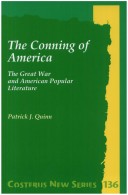Costerus New
1 primary work
Book 136
The Conning of America examines for the first time from a literary perspective the propaganda writings produced in the United States during the period of World War I. This American propaganda literature was written in two distinct stages: the first stage was written by the pro-War establishment based on the East Coast of the United States before American entry into the conflict. It attempted to vilify Germany and her Allies while at the same time showing England, France, and Russia as the victims of a well-planned organized German plan for world domination-beginning with the invasion of neutral Belgium. The literature urged the United States to prepare for a German invasion of America and to be wary of German-Americans, who most likely were spies in the employ of the Imperial German government. The second stage of propaganda literature occurred when America declared war on the Central Powers in April 1917.
While still using the blood thirsty militaristic Hun as a symbol of German inherent evil, the propaganda literature began to portray the Americans as the saviors of European culture. American boys were being sent to Europe on a spiritual mission to purify decadent European culture, while at the same time their sacrifice would rejuvenate and sanctify American values in the fire of the conflict in order for America to take her proper place in the new post-war order.
While still using the blood thirsty militaristic Hun as a symbol of German inherent evil, the propaganda literature began to portray the Americans as the saviors of European culture. American boys were being sent to Europe on a spiritual mission to purify decadent European culture, while at the same time their sacrifice would rejuvenate and sanctify American values in the fire of the conflict in order for America to take her proper place in the new post-war order.
